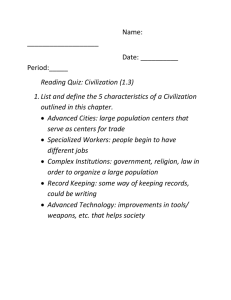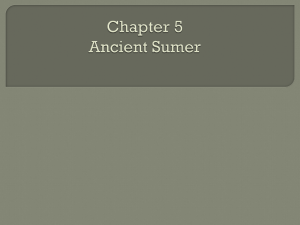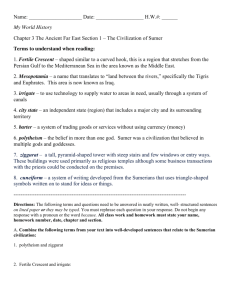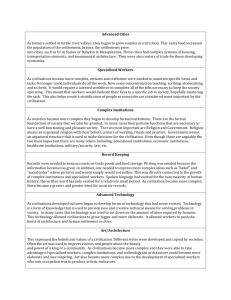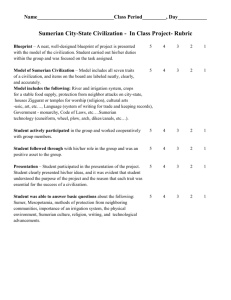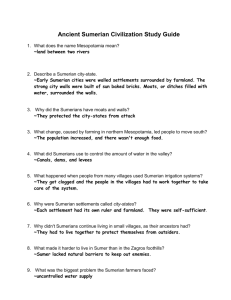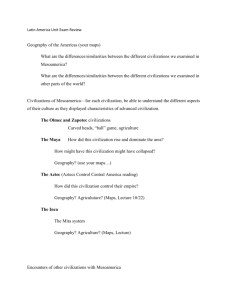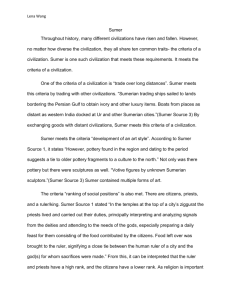Key Traits of Civilization reading
advertisement
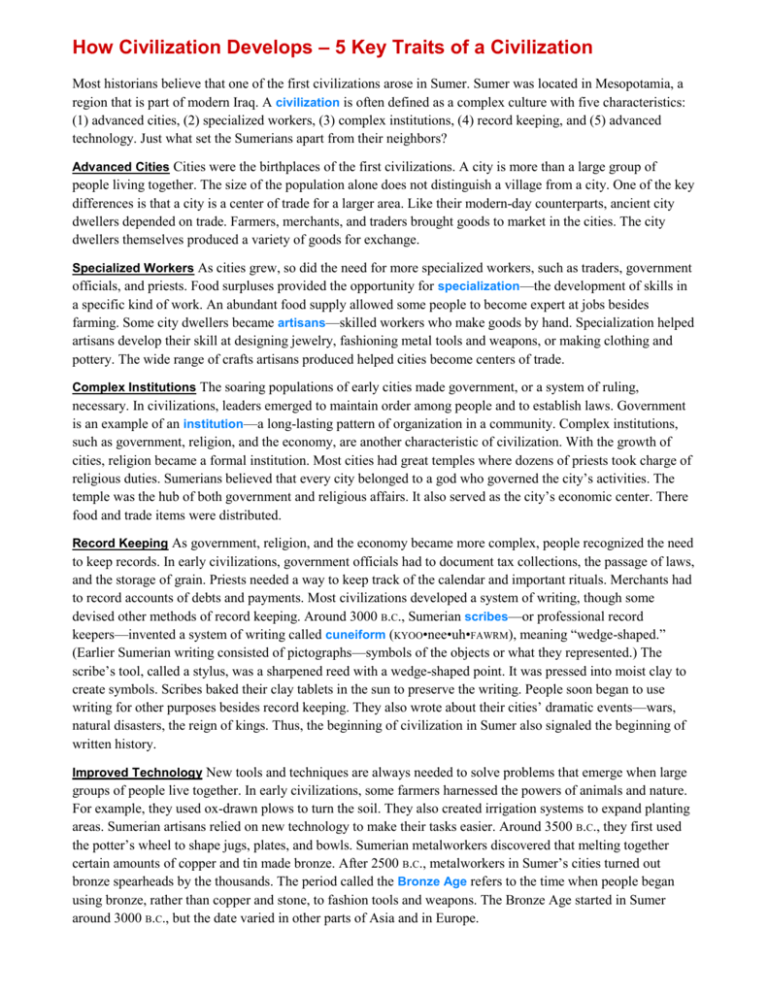
How Civilization Develops – 5 Key Traits of a Civilization Most historians believe that one of the first civilizations arose in Sumer. Sumer was located in Mesopotamia, a region that is part of modern Iraq. A civilization is often defined as a complex culture with five characteristics: (1) advanced cities, (2) specialized workers, (3) complex institutions, (4) record keeping, and (5) advanced technology. Just what set the Sumerians apart from their neighbors? Advanced Cities Cities were the birthplaces of the first civilizations. A city is more than a large group of people living together. The size of the population alone does not distinguish a village from a city. One of the key differences is that a city is a center of trade for a larger area. Like their modern-day counterparts, ancient city dwellers depended on trade. Farmers, merchants, and traders brought goods to market in the cities. The city dwellers themselves produced a variety of goods for exchange. Specialized Workers As cities grew, so did the need for more specialized workers, such as traders, government officials, and priests. Food surpluses provided the opportunity for specialization—the development of skills in a specific kind of work. An abundant food supply allowed some people to become expert at jobs besides farming. Some city dwellers became artisans—skilled workers who make goods by hand. Specialization helped artisans develop their skill at designing jewelry, fashioning metal tools and weapons, or making clothing and pottery. The wide range of crafts artisans produced helped cities become centers of trade. Complex Institutions The soaring populations of early cities made government, or a system of ruling, necessary. In civilizations, leaders emerged to maintain order among people and to establish laws. Government is an example of an institution—a long-lasting pattern of organization in a community. Complex institutions, such as government, religion, and the economy, are another characteristic of civilization. With the growth of cities, religion became a formal institution. Most cities had great temples where dozens of priests took charge of religious duties. Sumerians believed that every city belonged to a god who governed the city’s activities. The temple was the hub of both government and religious affairs. It also served as the city’s economic center. There food and trade items were distributed. Record Keeping As government, religion, and the economy became more complex, people recognized the need to keep records. In early civilizations, government officials had to document tax collections, the passage of laws, and the storage of grain. Priests needed a way to keep track of the calendar and important rituals. Merchants had to record accounts of debts and payments. Most civilizations developed a system of writing, though some devised other methods of record keeping. Around 3000 B.C., Sumerian scribes—or professional record keepers—invented a system of writing called cuneiform (KYOO•nee•uh•FAWRM), meaning “wedge-shaped.” (Earlier Sumerian writing consisted of pictographs—symbols of the objects or what they represented.) The scribe’s tool, called a stylus, was a sharpened reed with a wedge-shaped point. It was pressed into moist clay to create symbols. Scribes baked their clay tablets in the sun to preserve the writing. People soon began to use writing for other purposes besides record keeping. They also wrote about their cities’ dramatic events—wars, natural disasters, the reign of kings. Thus, the beginning of civilization in Sumer also signaled the beginning of written history. Improved Technology New tools and techniques are always needed to solve problems that emerge when large groups of people live together. In early civilizations, some farmers harnessed the powers of animals and nature. For example, they used ox-drawn plows to turn the soil. They also created irrigation systems to expand planting areas. Sumerian artisans relied on new technology to make their tasks easier. Around 3500 B.C., they first used the potter’s wheel to shape jugs, plates, and bowls. Sumerian metalworkers discovered that melting together certain amounts of copper and tin made bronze. After 2500 B.C., metalworkers in Sumer’s cities turned out bronze spearheads by the thousands. The period called the Bronze Age refers to the time when people began using bronze, rather than copper and stone, to fashion tools and weapons. The Bronze Age started in Sumer around 3000 B.C., but the date varied in other parts of Asia and in Europe.

